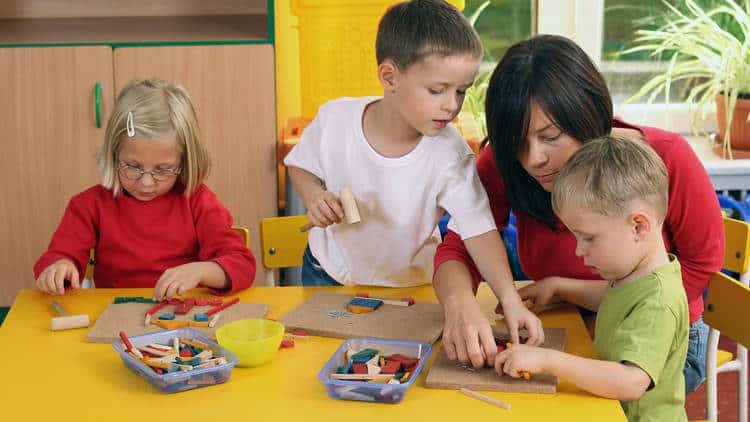These parent-child activities support the development of cooperation and self-control, important skills a child will use throughout their life.
The Gather Round activities are designed to help families promote their child’s language and literacy skills, while also nurturing the other domains of development (thinking, language and communication, social-emotional, and physical skills). A children’s book is suggested for each topic area and age (birth to 12 months, 12-24 months, and 24 to 36 months) and activities related to the book based on a range of developmental domains and early skills. The activities can be used with parents as a tool to promote children’s learning through book-sharing and age-appropriate parent-child activities.
Birth to 12 Months
Book:
Five Little Monkeys Jumping on the Bed by Eileen Christelow
Publisher: HMH Books
Activities that build on the ideas in Five Little Monkeys
1. Sing the Five Little Monkeys rhyme, using your fingers to stand in for each monkey. Five little monkeys jumping on the bed (hold up your hand and bounce if up and down), one fell off… (hold up one finger and “jump” it up), mama called the doctor… (hold your hand like a phone to your ear), no more monkeys jumping on the bed (shake your index finger “no”). Adding hand motions to songs is very engaging to children and helps them follow along and learn new words.
2. Of course, babies are far too young to follow rules. They do not yet have the memory or the self-control to remember or stick to rules. They also do not yet have the thinking skills to really understand rules. But you can begin to practice games of cooperation. Take turns putting objects (such as blocks or small baby spoons) into a box or basket; then take turns taking them out. Take turns handing these objects back and forth. As you do, extend your hand and say, “Can I have it?” and “Thank you!” to your baby. This helps your little one learn the meaning of gestures and words.
3. Have fun bouncing like the monkeys in the book! Make your own “bouncy area” by piling up cushions on the floor. Sit on the floor, hold your baby securely, and “bounce” her on the cushions while singing Five Little Monkeys. This type of game helps your baby develop balance, as well as leg and trunk (her middle) strength.
4. Play “monkey see, monkey do” with your baby. Beginning at about 6 months, see if your baby is interested in imitating your facial expressions (smiles, sticking out your tongue) or gestures (waving, clapping, arms raised for “up,” etc). Imitation helps your child learn to communicate using his body and also teaches him that he can look to you as a role model.
5. Make a monkey puppet out of a sock that has lost its match. Glue on eyes, ears, and a big smile (or draw on with markers). As you sing the Five Little Monkeys rhyme, put your sock puppet on your hand and have it sing along too. Does your baby reach for the puppet or laugh at his silly face? Maybe the monkey puppet can give your baby a big kiss!
12–24 Months
Book:
How Do Dinosaurs Say Good Night? by Jane Yolen
Publisher: Scholastic
Activities that build on the ideas in How Do Dinosaurs Say Good Night?
1. Take turns pretending to be LOUD dinosaurs and quiet dinosaurs. When you are a LOUD dinosaur, the two of you can ROOOOOOAARRR! When you are quiet dinosaurs, you can whisper roooaaarrr! Games like this help toddlers practice self-control when they have to follow simple rules and be loud only when it’s “loud dinosaur time.” If your child forgets, you can remind him by whispering, “shhhh, it’s quiet dinosaur time. It’s time to whisper a little tiny roar.”
2. The dinosaurs in this story each look very different. Some are bumpy, some are smooth, and some have rough skin. They are different colors and some have spots. Find child-safe objects around your house for your child to touch—like a bumpy egg carton, a woven basket, or the smooth side of the sink. Toddlers love to explore through touch which helps them learn new words and ideas.
3. As your child gets closer to turning 2 years old, she will be able to act out the different parts of the stories you are sharing. See if your toddler would like to pretend to put you to bed, tuck you in, and give you a kiss good-night. Then she can decide when it is “wake-up time” for her dino-mom or dad. Your child’s thinking skills grow when you join her pretend play and help her build the story.
4. In this book, the dinosaur enjoys a piggyback ride. Let your child know you appreciate his cooperation (with tooth-brushing or sitting still while you tie his shoes) by offering a piggy-back ride as a special treat: “Thank you for sitting still while I zipped up your jacket. Would you like a piggy-back ride to the car? ”This surprise addition to the usual daily routine teaches your child that cooperation is fun for everyone.
5. This story shows how difficult the night-time separation can be for young toddlers. Over time, your child will develop greater self-control and have an easier time “saying good-bye” to you at bedtime. You can help by creating a calm and loving bedtime routine. Consider adding a special ritual especially for saying goodnight—like kissing your child’s palm or fluttering the blankets like “butterfly wings” or “choo-choo-ing” the covers up to his chin.
24–36 Months
Book:
Please Baby Please by Spike Lee
Publisher: Little Simon
Activities that build on the ideas in Please Baby Please
1. Toddlers love discovering treasures, like the dandelion in the story. Create an “indoor sand box” for your child by filling a shoebox with dry macaroni, cornmeal, or rice. Hide some small toys or shells in the box for your child to find while she is digging. Of course she will probably drop some “sand” during this activity. If you give your child a small dust broom to use, she might really enjoy helping you sweep up!
2. In this story, there are clocks on every page that show how this toddler’s activity changes depending on the time of day. Toddlers thrive on daily routines so this is the perfect time to create a visual schedule for them. Collect pictures of children waking up, going to sleep, brushing teeth, playing, eating, and so on. (You might draw them yourself, cut them out from magazines, or find them online.) Glue each of these pictures onto a different piece of paper and post them, in the order you typically do each activity, on a wall at your child’s height. Then your child will begin to learn: “I am playing now, but next I will eat lunch.” This helps reduce power struggles and tantrums because your child can prepare for what will happen next.
3. In this story, the baby’s bedtime routine is a bath, pajamas, some special time with Mommy, and then a big kiss. Routines help your child feel safe and secure. Create special routines for your toddler to help make daily transitions easier. Consider developing a routine for everyday experiences such as bedtime, naptime, and bath.
4. The toddler in this story is not quite sure she wants to share. You can help your toddler begin developing turn-taking skills by playing simple games like rolling a ball back and forth or making a jack-in-the-box pop out. As you roll the ball, say: “It’s my turn.” As your child rolls the ball, you can say: “It’s [your child’s name]’s turn.”
5. As this board book shows, toddlers are go, go, go! Help your toddler practice self-control by playing a simple “stop and go” game. Color one side of a paper plate red and write the word stop on it. Color the other side green and write the word go. Ask your child to stand down the hall from you and teach him that he can hop forward when he sees “green for go” and that he stops when he sees “red for stop.” Maybe he would like a turn to hold the “stop/go” sign and you can follow the directions too!




